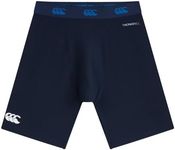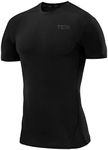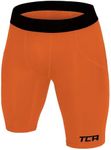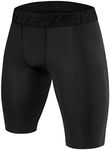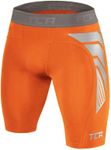Buying Guide for the Best Mens Compression Shorts
When choosing men's compression shorts, it's important to consider how they will be used, as this will guide you in selecting the right features and specifications. Compression shorts are designed to provide support, improve circulation, and enhance performance during physical activities. They can be used for various sports, workouts, or even as a base layer for everyday wear. Understanding the key specifications will help you make an informed decision that aligns with your needs and preferences.MaterialThe material of compression shorts is crucial as it affects comfort, breathability, and moisture-wicking capabilities. Common materials include polyester, spandex, and nylon, often blended to provide stretch and support. Polyester is durable and moisture-wicking, making it suitable for intense workouts. Spandex offers excellent elasticity, ensuring a snug fit. Nylon is lightweight and breathable, ideal for warmer climates. Consider your activity level and climate when choosing the material. For high-intensity workouts, opt for a blend that emphasizes moisture-wicking and breathability. For everyday wear, comfort and stretch might be your priority.
Compression LevelCompression level refers to how tightly the shorts fit against your body, which can range from mild to firm. Mild compression is suitable for everyday wear or low-impact activities, providing comfort and slight support. Moderate compression is ideal for regular workouts, offering enhanced support and improved circulation. Firm compression is best for high-intensity sports or recovery, as it provides maximum support and muscle stabilization. Choose a compression level based on your activity type and personal comfort preference. If you're new to compression wear, starting with moderate compression might be a good balance.
Fit and LengthThe fit and length of compression shorts can affect both comfort and performance. Fit should be snug but not restrictive, allowing for a full range of motion. Length varies from mid-thigh to knee-length, with shorter lengths offering more freedom of movement and longer lengths providing additional muscle support. Consider the type of activity you'll be doing; for running or cycling, longer shorts might prevent chafing, while shorter shorts could be preferable for gym workouts or layering under other clothing. Personal comfort and the specific demands of your sport should guide your choice.
WaistbandThe waistband of compression shorts plays a significant role in comfort and fit. A good waistband should be wide enough to stay in place without digging into your skin. Elastic waistbands are common and provide a secure fit, while some may have drawstrings for additional adjustability. Consider your comfort preference and the intensity of your activity. For high-impact sports, a secure waistband is essential to prevent the shorts from slipping. If you prefer a more relaxed fit, look for shorts with a softer, more flexible waistband.
Moisture-Wicking and BreathabilityMoisture-wicking and breathability are important features that help keep you dry and comfortable during physical activities. Moisture-wicking fabrics draw sweat away from your skin, while breathable materials allow air to circulate, preventing overheating. These features are particularly important for high-intensity workouts or hot climates. If you tend to sweat a lot or exercise in warm conditions, prioritize shorts with excellent moisture-wicking and breathability. For cooler environments or less intense activities, these features might be less critical but still beneficial for overall comfort.








